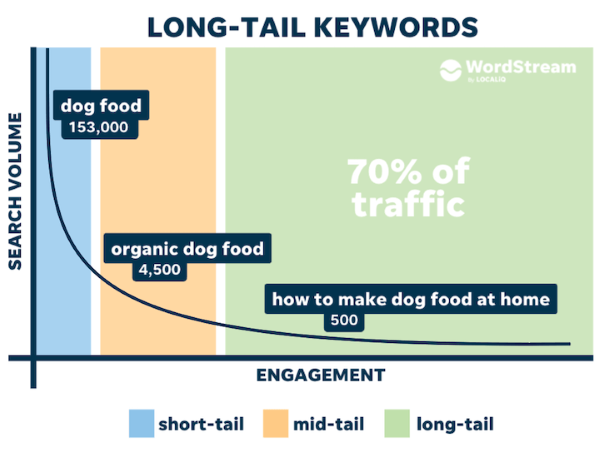How to Create and Implement an Effective SEO Keyword Strategy

This article was originally published on October 14th, 2021 but was updated on June 22nd, 2022.
If you want to increase your website traffic and improve your online presence, an effective SEO keyword strategy can make all the difference. Recent research by the Content Marketing Institute found that web visitation is the most popular metric used to assess the effectiveness of content promotional activities in demand creation and lead generation. Of course, to get more inbound traffic, companies need to have an optimized website. Marketers can utilize website content to reach previously unreachable populations of prospective consumers by following the fundamental principles of search engine optimization.
Although Google’s algorithm improvements aim to emphasize the quality of information, consumers will still have to enter in a query to receive relevant results. Fortunately, adopting a few easy best practices may help any marketer enhance their content and stay relevant online. Here is a step-by-step process to follow to create and implement an excellent SEO keyword strategy into your content:
6 Steps to Create and Implement an SEO Keyword Strategy
Step #1: Identify Your Target Audience
When it comes to SEO, the goal is to provide the best possible user experience while also presenting the most relevant content. As a starting point for content creation, you must first identify your target audience. Before you begin any keyword research for content marketing, it helps to start identifying your audience. Here are some questions to ask when finding your intended market and target keywords:
What are the demographics and psychographics of your present clients?
You may get a better idea of your prospects by analyzing the qualities of your existing clients. Analyze quantitative and qualitative data, such as gender, age, buying patterns, and users’ interaction with web pages. All of these things might help you get a better idea of your target audience.
What are your competitors’ strengths and weaknesses?
You can learn a lot from your business from finding what your competitors may be lacking in that your business could provide for potential customers. What types of keywords do they currently rank for? Understanding strengths and weaknesses can provide keyword ideas and areas to focus on or ignore.
What do your clients expect from you?
Analyze your offerings to see what value they provide to your customers. Who stands to gain if those outcomes are realized? What is your general opinion about yourself? Learning your customers’ expectations will give you ideas for a more effective SEO keyword strategy.
Do you have a good understanding of how your customers feel about you?
To discover more about your audience, perform a survey. Find out what your audience likes, what you can do better, and what information they want to learn from you. Keep the survey simple – individuals tend to keep keyword queries short and straightforward. From the survey data, analyze your customers’ needs and what they look for to understand which keywords to focus on.
Understanding your target audience is an ongoing process. Trends, products, and services will change, and so do consumer behaviors. The answers to these questions can help give you a place to start. The ideas will help provide a better direction and focus on what keywords you should look for when performing keyword research.
Step #2: Perform Keyword Research
The second (and ongoing) step in your keyword SEO strategy should be keyword research. Keyword research has changed throughout the years, but is still essential for any effective SEO content plan. It helps you come up with a list of different ideas and terms that individuals could type into a SERP (search engine result page).
Keyword research is how you discover and choose the best keywords to use on your website. There are numerous keyword research options available to assist marketers in selecting effective keywords. At Boostability, we offer keyword research services to help your site rank on search engines, increase traffic, and bring in new customers for your business.
As discussed above, keyword research starts with understanding your target audience. Now that you understand your potential customers, consider what keywords they search for online. With many industries, keyword research is quite simple. For example, a dental practice should focus on the relevant, obvious keywords like “dentist”, “dentistry” or “dental office”. With more complex industries, you may need to use a keyword research tool to find the best keyword options. When using the keyword research tools, keep in mind that search volume isn’t everything. Focus on search intent when choosing keywords.
4 Different Types of Search Intent:
- Informational: user is looking for an answer or more information about a topic.
- Navigational: user wants to find a specific web page or physical location.
- Commercial: user wants to learn more about a brand or service offered.
- Transactional: user wants to take action (purchase, sign up, etc).
If you want to rank for a keyword, make sure the page you create or optimize matches the intent of the keyword search. For example, the keyword “dentist” has commercial/transactional search intent. In contrast, the keyword “how to choose a dentist” is more informative. Create your target page and implement your focus keyword based on the search intent. For more commercial/transactional intent, focus on creating main menu landing pages. It’s best to create a blog or resource page for informational keywords.
Here is some free keyword research ideas and tools to help you begin your search:
- Google Autocomplete / People Also Ask: Automated Google suggestions during and after a search is performed.

- Keyword Surfer: Free browser plugin to give you ideas on search volume, traffic, and ranking pages.
- AnswerThePublic: Created by UberSuggest, this gives you more ideas on what people search related to a 1-2 word search query.
- Google Search Console: Requires verification but provides accurate and reliable keyword ideas based on your industry – strait from Google. Follow these steps to easily verify your Google Search Console account.
Step #3: Create a Page For Each of Your Topics
Based on search intent, create new pages for each service / product / topic in order to match up with the search query. Don’t stuff a page with many different keywords. Search engines can see this and will flag your website for “keyword stuffing” and rankings could drop or never improve. Create a web page or blog post based on the key subjects you offer, utilizing both short and long-tail keywords. Your company’s offering – or the number of products and services you provide, should determine the number pages you create. Regardless of the search terms your potential and current customers search, it will help improve your visibility and awareness online.
Step #4: Use Keywords Effectively
You could be new to SEO or be an expert in the field, however keywords can sometimes be tricky to fully comprehend. With rankings fluctuating over time due to search trends and updates, learning how to use the right keywords at the right time to get the highest ranking can be challenging. However, when you properly use keywords in the right areas of your content, you can increase your rankings in SERPs – allowing individuals to find your website and content. Using keywords effectively will help your SEO keyword strategy succeed over time. Follow these best practices to use keywords more effectively:
- Implement keywords on web pages that match up with the search results and intent.
- Optimize the Meta Title, Meta Description, and heading tags (especially H1) with the target keywords.
- Use the keyword within the text based on the length of the web page or blog. A small amount of text should not be over-stuffed with the target keyword.
- When there is an image on the page, include the keyword within the alt image tag or description.
Step #5: Implement Long-Tail Keyword Phrases
Long-tail keywords are generally used to answer informational queries and questions. In the graphic below, the example of a short-tail keyword is shown as “dog food”. The example long-tail keyword is “how to make dog food at home”. See the difference? One keyword could be based on a product search while the other is looking for an answer to a question.

As mentioned above, search intent should play a significant role within your SEO content strategy. Long-tail keyword phrases offer an excellent way to rank on search engines to answer “informational” intent searches. Long-tail keywords also have less competition in search results, boosting the chances of better rankings. When individuals (other blogs or customers) find your blog pages to be informative, they are more likely to link to your website – creating backlinks! Each of these aspects play a role in an effective SEO content strategy, helping to boost rankings and website traffic.
Step #6: Keep Optimizing, and Make it Unique
Now it’s time to go to work optimizing, and making your content look better as you implement your SEO keyword strategy. Map out new pages based on your refined keyword strategy. Work on optimizing existing pages for trending keywords and updated information. An optimized website is not like a lightswitch that you turn on and off, it’s an ongoing process of strategic improvements. Although you can fit SEO strategy into a framework, it’s important to keep things unique. Just like any shopping experience, online buyers are looking for products and services that are unique, better, and special. They want to feel that they received the best deal along with the best service/information. An optimized keyword strategy should create a natural and easy experience for potential customers and search engines.
Boosting Your SEO Keyword Strategy
The selection of keywords plays a crucial role in any effective SEO-lead content marketing strategy. At Boostability, we track millions of keywords every month to fuel our data-driven decisions. We provide keyword research services for small businesses looking to improve their website traffic. Our white-label SEO services can help your team expand its digital marketing strategy. If you are looking for a way to boost your customer’s rankings online, reach out to our team of professionals today.

